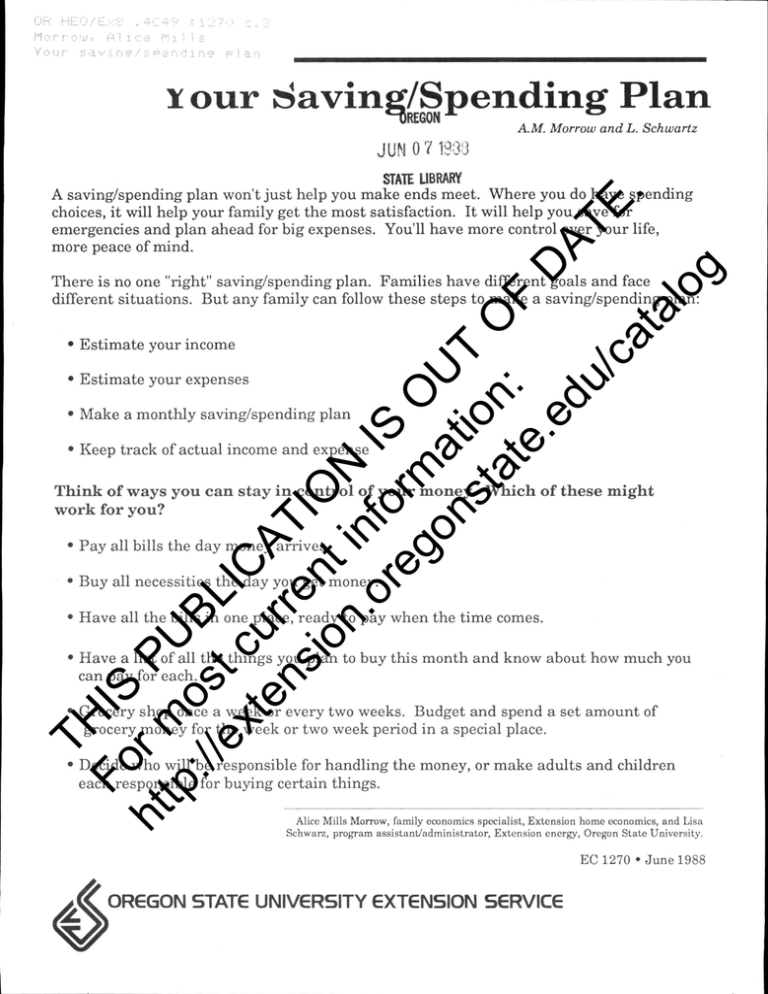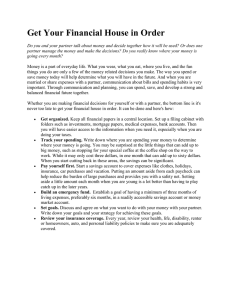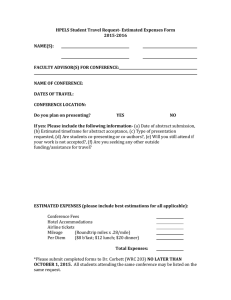our Savinon/Spending Plan Y
advertisement

Y our Savinon/Spending Plan REGON A.M. Morrow and L. Schwartz JUN 0 7 13J STATE LIBRARY Fo IS ht r m P U tp :// os BL ex t c IC te ur A ns re TI io nt ON n. in or fo IS eg rm O on at U st ion T O at : F e. D ed A u/ TE ca . ta lo g A saving/spending plan won't just help you make ends meet. Where you do have spending choices, it will help your family get the most satisfaction. It will help you save for emergencies and plan ahead for big expenses. You'll have more control over your life, more peace of mind. There is no one "right" saving/spending plan. Families have different goals and face different situations. But any family can follow these steps to make a saving/spending plan: Estimate your income Estimate your expenses Make a monthly saving/spending plan Keep track of actual income and expense Think of ways you can stay in control of your money. Which of these might work for you? Pay all bills the day money arrives. Buy all necessities the day you get money. Have all the bills in one place, ready to pay when the time comes. Have a list of all the things you plan to buy this month and know about how much you can pay for each. TH Grocery shop once a week or every two weeks. Budget and spend a set amount of grocery money for the week or two week period in a special place. Decide who will be responsible for handling the money, or make adults and children each responsible for buying certain things. Alice Mills Morrow, family economics specialist, Extension home economics, and Lisa Schwarz, program assistantladministrator, Extension energy, Oregon State University. EC 1270 4OREGON STATE UNIVERSITY EXTENSION SERVICE June 1988 Step 1: Estimate your income. Income Amount Job/s elf employment Fo IS ht r m P U tp :// os BL ex t c IC te ur A ns re TI io nt ON n. in or fo IS eg rm O on at U st ion T O at : F e. D ed A u/ TE ca . ta lo g The first step in making a saving/spending plan is to figure out the income of all family members. It is important to be accurate and include only income that is "for sure," not what "might be." If your income varies from month to month, figure average monthly income. If the yearly estimated income from one source is $9,600, the average monthly income is $800 ($9,600/12 months = $800/month). If there are times of the year when you don't have any income, you need to save money for these times. Know which months you expect less income and which months you expect more. Job/self employment Overtime and part-time work Alimony and child support Social Security Veteran's benefits Worker's Compensation Food stamps, WIC and AFDC Unemployment insurance Other Total income this month To convert weekly income to monthly income, multiply weekly income by 4.33. TH Step 2: Estimate your expenses. Use old bills, cancelled checks and receipts to help you estimate expenses. There always are expenses you don't expect auto repairs, dental and medical bills, and appliance repairs, for example. You may want to set up a special emergency fund or keep extra money in your regular savings to pay for these things. Some expenses, such as car insurance, holiday expenses, back to school clothes and property taxes, Expense Rent or mortgage House and auto insurance Property taxes FederallOregon income taxes Electricity and gas Water and sewer Telephone Amount Fo IS ht r m P U tp :// os BL ex t c IC te ur A ns re TI io nt ON n. in or fo IS eg rm O on at U st ion T O at : F e. D ed A u/ TE ca . ta lo g occur only once or twice a year. Know what months you have these expenses. Figure the average monthly cost. For example, if the car insurance bill is $240 for 6 months, the average monthly cost is $40 ($24016 months = $40). Set aside $40 each month for this expense. Can you make arrangements for monthly payments of expenses such as car insurance or property taxes? TH Look at loan payments. When will a loan be completely paid? When it is paid, consider saving some of the money that you used to set aside for the payments. Think about expenses you can reduce. Change this list of expenses to fit your family's needs. If you have expenses not listed here, write them in. Cable TV Child care Life and health insurance Loan payments For car For furniture and appliances For other items Food at home Food away from home Clothing Transportation (gas, auto parts and repair, bus fare) Contributions Personal care Medicalldental Recreation Household supplies Educational expenses Other Savings Total expenses this month Step 3: Make a monthly saving/spending plan. . ..Lr\C..orr,Q.. frar's net 7ômary -ober' pree q ccyor a.0 cc'r r-)s S.Pd.e.ac\ Oc\3c..*,r7L2..12 Fo IS ht r m P U tp :// os BL ex t c IC te ur A ns re TI io nt ON n. in or fo IS eg rm O on at U st ion T O at : F e. D ed A u/ TE ca . ta lo g Now that you have estimated monthly income and expenses, you can make a saving/spending plan each month. On a piece of paper, list the income available to spend this month. Using your list of expenses (Step 2), itemize the expenses that you will have this month. Look ahead to see what money must be set aside for future expenses. It's okay if every penny isn't budgeted. In fact it's good to have some leeway for the unexpected. In their October plan, Stan and Rosemary listed the paycheck Stan receives the end of September and the money Rosemary earns each week caring for the neighbor's children. They set aside money toward property tax due in November and auto insurance due in January. Rosemary hopes they can set aside the money left over for the holidays. Stan and Rosemary will keep track of all their expenses in October (Step 4) so that they will be able to make a more accurate and complete plan in November. E moc*3e. 132. .00 (&.o") C.ab\e_W .00(or1 a- \we 300 .CO O,00 C\o'ra &scors .oc*a4 ecA) LSO\d, S\ \L, Oth p ro er'- 00 .C&1abktr3 ir4a\\ec * j( 6 as\e..c1r 2OO 0 eprr' tr 42.s4.co) +s7.Lj2. Step 4: Keep track of actual income and expenses. TH During the month write down the income you actually receive and the money you spend. Make one household member responsible for recording how much money the household spends. Everyone needs to cooperate by telling the recordkeeper how much they spend. Compare actual expenses to the plan you made in Step 3. If you overspend in one area, adjust the plan. For example, Rose- mary and Stan's phone bill comes and it is $27.00 rather than $17.00. Can they reduce the cost of household supplies? Should they try to reduce next month's phone bill by making fewer long distance calls? If your plan isn't perfect, don't be discouraged. It may need to be changed often because your family's activities are always changing. Extension Service, Oregon State University, Corvallis, O.E. Smith, director. Produced and distributed in furtherance of the Acts of Congress of May 8 and June 30, 1914. Extension work is a cooperative program of Oregon State University, the U.S. Department of Agriculture, and Oregon counties. Oregon State University Extension Service offers educational programs, activities, and materials without regard to race, color, national origin, sex, or disability as required by Title VI of the Civil Rights Act of 1 Title IX of the Education Amendments of 1 972, and Section 504 of the Rehabilitation Act of 1973. Oregon State University Extension Service is an Equal Opportunity Employer.



